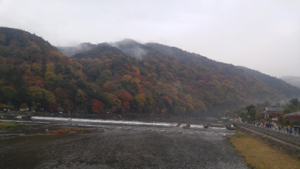Want to see the real Kyoto
Yoshie Doi
 Arashiyama |
 Kenninji Temple |
My daughter’s classmates during her stay in England came to Japan from Spain. We decided to have lunch together on November 21st, the day he arrived in Kyoto, and it was the first time in five years since we had eaten at a restaurant near Sagrada Familia in Barcelona five years ago. We were happy to meet again after a long time.
Apparently, he met my daughter again in Tokyo. he wanted to eat local food and visit places that aren’t touristy in Kyoto. Many people tend to focus on famous sightseeing spots, but he also wanted to such as stay at a temple, so I showed them a restaurant where I usually go for lunch. He was told it was very delicious and devour double order of lunch. As a guide, I was very happy and was convinced that I could communicate with people from all over the world through food.
In March 2018, I was in charge of a commemorative Japan seminar in Madrid to mark the 150th anniversary of the establishment of diplomatic relations between Spain and Japan. Co-sponsored by JNTO and JETRO, with the cooperation of CASA ASIA and the Japan Foundation, this is a series of seminars on themes that touch on Japanese tradition, culture, and lifestyle.
As the first seminar, “Kyoto Sparrow School in Spain” was held. With the theme of [Learning about the deep charm and lifestyle culture of Kyoto that are not found in guidebooks], he will be holding four lectures on the second floor of his CASA ASIA near the National Assembly building in Madrid. A friend from Spain requested the same thing as that course I gave on this occasion.
He is a Japanese-loving Spaniard and he has been studing hiragana before came to Japan, but found kanji difficult. On the first day of his visit to Kyoto, he regretted coming to Japan for two weeks and regretted that he should have been able to stay longer.He was impressed and said, “Kyoto is the best, the culture, history, atmosphere, and food are great.”
Spain is ancient and has a culture different from the rest of Europe, but is Japan special? Whether it’s sightseeing or dining, you can only understand the culture of a region by interacting with the local residents. No matter which region you visit around the world, I believe that tourism that allows you to interact with local residents is the true form of tourism. We believe that this is the true nature of tourism.
When I went to a department store to buy souvenirs, I found Daifuku tea for the New Year on sale, and when I handed it to them and said, “This is a special tea to drink on New Year’s Day in Kyoto,” I was told that Spain also has special fruits that are eaten on New Year’s Day. I think the feeling of eating food on New Year’s Day and praying for good health throughout the year is the same in all countries.
I was also surprised to learn that all movement within Kyoto city was done on foot. About 10 years ago, when I guided an architectural designer from Portland, USA, I suggested that he walk around the building. Up until now, he had been traveling by car, but he made new discoveries and was very happy. The speed and distance you can get around on foot in Kyoto is life-size, so I think it’s just right.
The end of document
Translated by Masami Otani
